Belarus Tour Guide: Ideas for Your Trip!
Things to see in Novogrudok, the first capital of the Grand Duchy of Lithuania and the homeland of Adam Mickiewicz
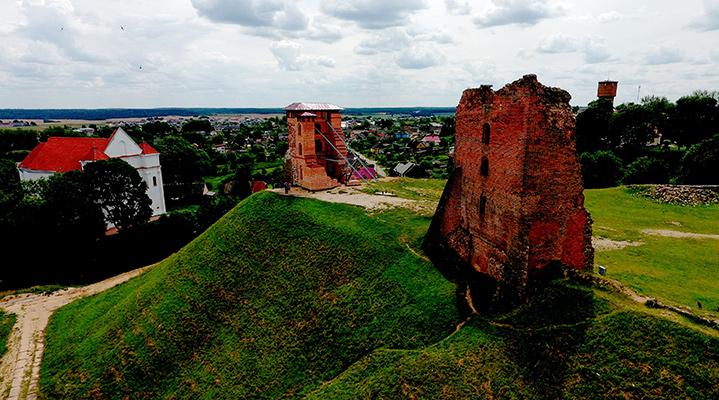
A cozy town with a very common name had a truly unusual, interesting past. Many centuries ago, it was the first capital of the Grand Duchy of Lithuania, one of the largest states of medieval Europe. Later, a stone castle was built there, which remained the most formidable fortress for a long time. King Jahajla married the young Princess Sophia of Golshany in the main church of Novogrudok in 1422 and thus started the famous Jagiellonian dynasty.
Throughout history, the name of the town slightly changed but the meaning remained the same - Novogorod, Novgorodok, or Novy Gorod, a new town in English. Novogrudok was first mentioned in chronicles in 1044 in reference to a war between Yaroslav the Wise and Lithuanian tribes. Yet, according to archaeologists, the first permanent settlements here date back to the end of the 10th century. The settlement kept growing throughout the 11th century, and in the 12th century it included a fortified stronghold and residential quarters.
Novogrudok quickly became the richest town in the lands along the Neman River. Agriculture and animal husbandry grew rapidly, crafts and trade flourished and the population rose manifold. By the 13th century, Novogrudok turned into a major political center. It gained even greater weight under Grand Duke Mindouh who initiated the unification of the lands around Novogrudok and the creation of a new state - the Grand Duchy of Lithuania. Novogrudok hosted the most important political events: sessions of the Sejm, the Tribunal of the Grand Duchy of Lithuania, high-profile meetings…
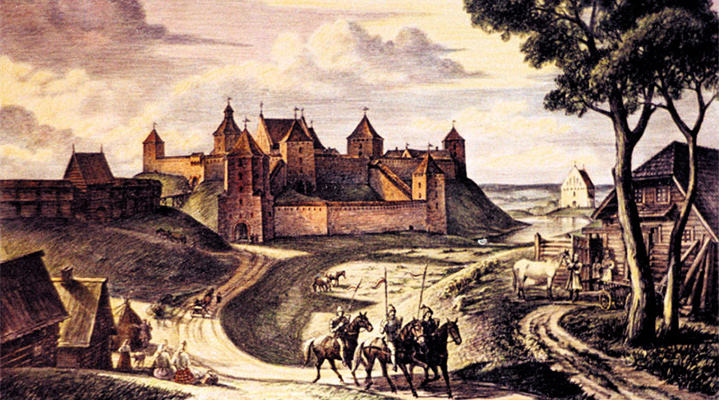
However, around 1323 Duke Hiedymin ordered to build a new fortified residence and moved the capital to Vilna. Novogrudok began to lose its significance. Due to numerous wars, fires and epidemics of the 17th -18th centuries, it gradually fell into economic decay.
Since the end of the 18th century, the town was part of the Russian Empire, during the First World War it was under the occupation of German troops, since 1921 - part of Poland, and after 1939 – part of the BSSR. During the Great Patriotic War, Novogrudok was occupied by the Nazis, was half destroyed and lost many thousands of its residents…
Today it is a beautiful quaint town that invites visitors to immerse themselves in history and learn about its amazing past. Unfortunately, only ruins survived of the castle on the ancient Castle Hill but they remind of many things. The place hosts regular historical reenactment and knights festivals. Novogrudok is the birthplace of the outstanding Romantic poet Adam Mickiewicz. His house-museum holds many rare artifacts.
Ruins of Novogrudok Castle
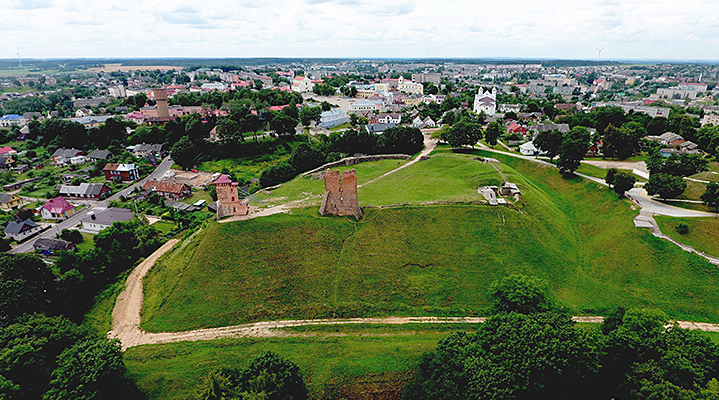
The first stone tower-donjon was built on the Castle Hill where the wooden stronghold was located in the 13th century during the reign of Mindouh. Called as the Shield Tower, it defended the town from the enemy many times, was destroyed and revived again. But still for a long time it remained the only stone fortification. It was not until the late 14th century that large-scale construction began here. On the hill there emerged walls and three-tiered stone towers with loopholes on each floor, Well Tower next to water springs, a stone temple and a two-story palace. A large Watchtower was built in the early 16th century. A thick stone wall connected the Watchtower with the Shield Tower thus making the fortress a ring-fort. The seven-tower castle became a key stronghold and one of the most formidable fortresses in the Grand Duchy of Lithuania.
Nevertheless, in the second half of the 17th century, many towers and walls were damaged in numerous battles and were completely destroyed during the Northern War. In 1802, by order of the Grodno governor, stones from the walls were used ... to pave the streets of the town. Remains of only two towers – the Shield Tower and the Church Tower – have survived through the centuries.
Today, the Castle Hill (320m above sea level) offers a beautiful panoramic view of the town. The surviving towers have been conserved. Tourists love to visit this iconic place, although it is only by looking at reconstruction drawings that we can imagine its former glory.
Mindouh Hill
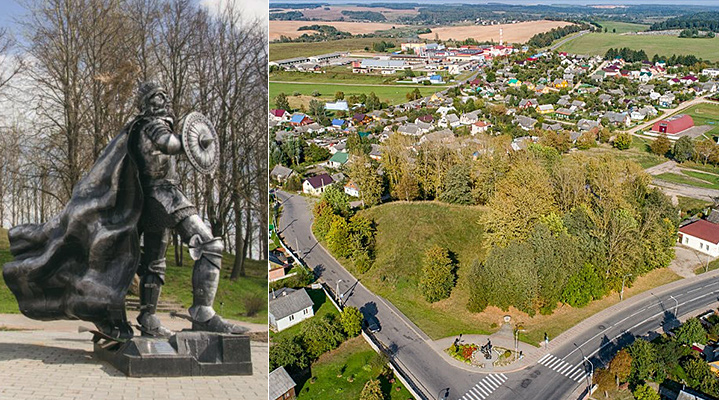
Mindouh Hill is a mysterious monument of the Middle Ages. A legend has it that it was on this hill that the founder of the Grand Duchy of Lithuania Mindouh was buried in the 13th century. He renounced Catholicism shortly before his death and was buried under the mound according to a pagan rite. According to another legend, Mindouh was crowned on the hill in 1253. He received from Pope Innocent IV the crown and the title of the King of Lithuania, the first and only. Adam Mickiewicz repeatedly mentioned this place in his works thus giving it an additional Romantic flair.
There was a Christian cemetery on the ancient hill from the late 17th century to the early 1920s. Old tombstones can still be seen there. People say that on top of the hill there was a slab depicting an angel girl. Beautiful Krysia is believed to be buried underneath. The slab was a handiwork of Italian sculptor Pietro Perti who later reproduced the face of his beloved one in statues for several churches in Vilna.
A commemorative plaque was unveiled at the foot of the hill in 1993 to mark the 740th anniversary of Mindouh’s coronation. A 2.5m high sculpture of the Knight was installed there in September 2014.
Entrance Gate commemorative plaque
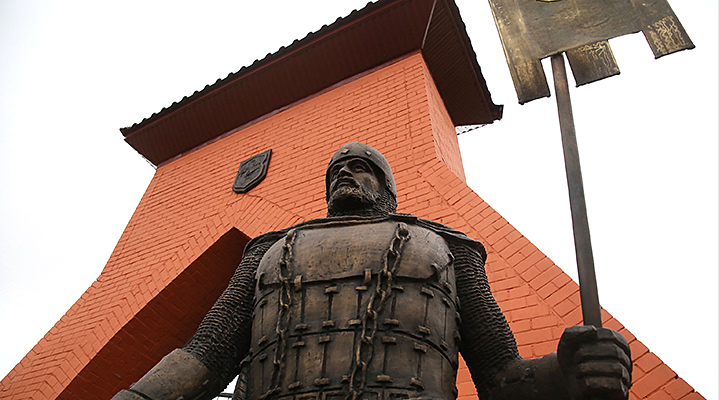
The landmark was unveiled in 2019 in the run-up to the 975th anniversary of Novogrudok. It is meant to highlight the long history and hospitality of the town. The thing is that the old entrance gate was destroyed during the Great Patriotic War and has not survived to this day. The new symbolic gate is located on Volchetsky Street. The brick arc guarded by a bronze warrior is decorated with bas-reliefs listing important dates in the history of Novogrudok.
Transfiguration Church
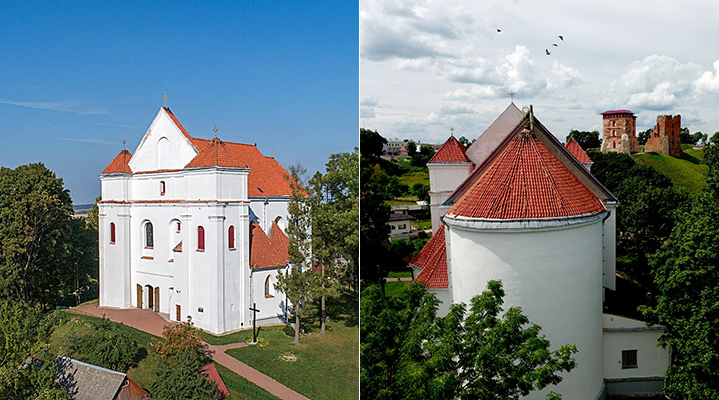
The Transfiguration Church, Farny Church, White Fara – these are the names of the main Catholic church in Novogrudok, one of the oldest churches in Belarus. In 2018 it got the title of a sanctuary, a place where revered relics are kept. The church was founded by Grand Duke Vitaut in 1395 shortly after the adoption of Christianity in the Grand Duchy of Lithuania. A stone-built church was erected in 1723 on the site of the wooden one. It combines elements of the Sarmatian Baroque and Gothic architecture.
For many centuries, the church was used as a fortress during hostilities. And of course, more than once it was a centerstage of landmark historical events. It was here where King Jahajla married Sophia of Golshany and where Adam Mickiewicz was baptized. The history of the monarchies of Monaco, Sweden and France was also intertwined with the church. The glory of the miraculous icon of the Mother of God of Novogrudok (Catholic interpretation) spread far beyond the town and the country. In his poem Grażyna, Adam Mickiewicz also thanked the icon for his recovery, and this is just one of many confirmed miracles.
The Farny Church keeps relics of Novogrudok martyrs - 11 Sisters of Nazareth who decided to share the fate of 120 men, including a priest, who were sentenced to death by the Nazis during the Great Patriotic War. In the morning of 1 August 1943 they were shot near the town, and in 1945 the remains of the nuns were reburied near the church. Thousands of believers come to honor the relics of blessed martyr Maria Stella and other sisters every year.
Where: 16 First of May Street
St. Michael the Archangel Church
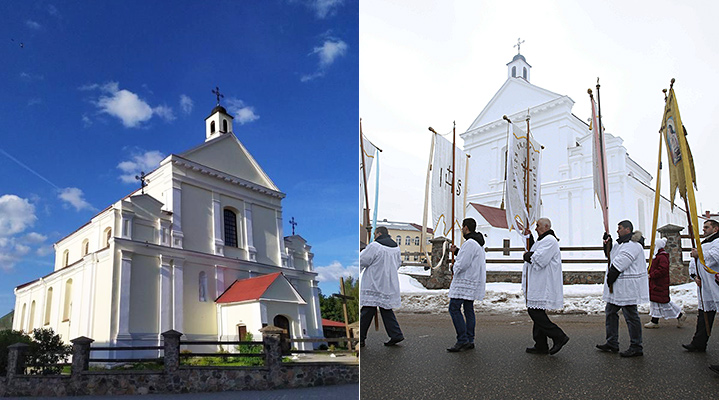
At the beginning of the 17th century, Lithuanian Voivode Krzysztof Chodkiewicz invited Dominicans to settled in Novogrudok: the monks of this religious order were known not only for the strength of their faith, but also for their striving for enlightenment and science. Soon a monastery was built for them and a wooden church appeared at the monastery in 1624. In the 18th century, the temple was covered with stone walls, but the old Baroque decor inside was retained. However, the fires of 1751 and 1831 destroyed or severely damaged many of the monastery buildings.
It is noteworthy that poet Adam Mickiewicz attended the school run by the Dominican monastery in 1807-1815. However, in 1832 the educational institution was closed, and in 1858 the monastery itself ceased to exist. The church was rebuilt in the Later Classicism style.
The history of the church had many twists and turns in the 20th century. After the Second World War the church itself was used as ... a warehouse and a shop. In the 1990s, the church was given back to believers and restored. It is a functioning church today. Its interior is decorated with murals and stucco moldings, and the main altar keeps an icon of the patron saint and defender of Novogrudok - St. Michael the Archangel.
Where: 16 First of May Street
Sts Boris and Gleb Church
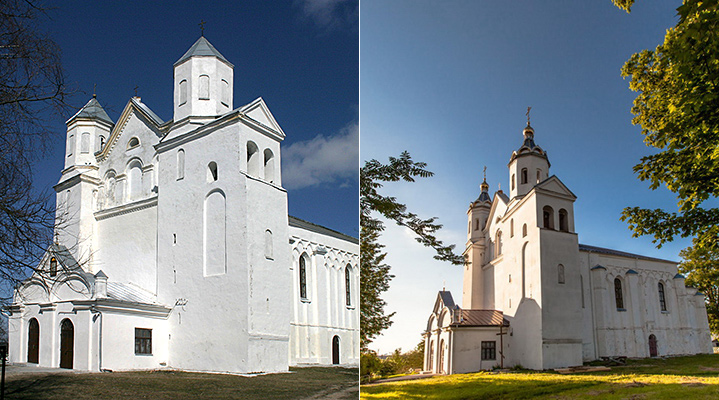
The Sts Boris and Gleb Church is Novogrudok’s oldest church. It is also known as the Cathedral of the Holy Martyrs and Passion-Bearers Boris and Gleb. The first stone-built church emerged on this place in the 12th century. It was the most beautiful religious building of its time. The church was lavishly decorated with frescoes, there were resonators in the walls and a wonderful majolica floor made of tiles of various shapes. In 1317, it became the cathedral church of the Metropolitanate of Lithuania and the center of the monastery.
The church went through large-scale renovations in 1517-1519. A new brick church was built here using the money of Great Hetman of Lithuania, Prince Konstanty Ostrogski and Metropolitan of Lithuania Iosif Soltan. Later on, the beautiful Gothic building changed owners more than once, it was restored and rebuilt acquiring the features of the Sarmatian Baroque, Renaissance, and pseudo-Russian style. This is how two towers with loopholes and spiral staircases inside appeared, many elements of the design were changed.
In the 20th century the cathedral was used as a branch of the state archive and was given back to the faithful once Belarus gained independence. The main relics of the cathedral - the icon of the Novogrudok Mother of God (Orthodox interpretation) and the icon in honor of the church patrons martyrs Boris and Gleb - attract pilgrims from all over the country and abroad.
Where: 10 Pochtovaya Street
St. Nicholas Cathedral

Centuries ago, on this site in the center of the town there was a monastery of Franciscans, whom Grand Duke Hiedymin invited to Novogrudok in 1323. The centerpiece of the monastery was the beautiful Baroque-style church of St. Anthony. Originally it was wooden, and later it was made of brick. In 1846, several decades after the closure of the Franciscan monastery, the temple was made Orthodox and consecrated in honor of Nicholas the Wonderworker.
In 1852, the church was damaged badly in a fire and was significantly rebuilt. The baroque pediment and other elements of the old building acquired features of the Russian-Byzantine style. It is an interesting fact that the eldest sons of Alexander II, Nicholas and Alexander, took part in the reconstruction of the cathedral as philanthropists. They donated a valuable icon of St. Nicholas and a sacrarium to the church. Great help was rendered by parishioners. Among the treasures of the temple are the 18th century icon Our Lady Hodegetria and the iconostasis of the second half of the 19th century.
Today the cathedral is double-altar: the main altar is in the name of St Nicholas the Wonderworker, the side altar is in the name of the Holy Great Martyr Tsarina Alexandra. In the crypt there is a church in honor of Saints Methodius and Cyril.
Where: 6 Grodnenskaya Street
Monument to Monk Elisey Lavrishevsky
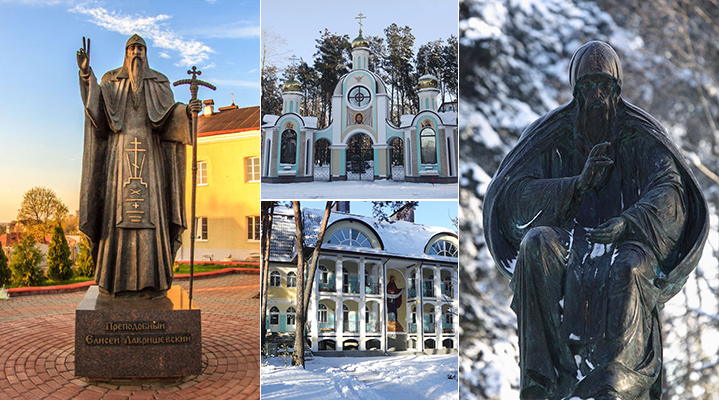
The three-meter high monument to famous Belarusian saint Elisey Lavrishevsky was erected in Novogrudok in 2007 to celebrate the 690th anniversary of the Novogrudok diocese and the 1015th anniversary of Orthodoxy in Belarus.
He was a duke’s son and held a very high position in the court of the first ruler of the Grand Duchy of Lithuania Mindouh. After being baptized, Elisey abandoned secular life. The monk is considered to be the founder of Lavrishevsky Monastery, one of the most ancient Belarusian monasteries, which existed in the village of Lavrishevo not far from Novogrudok in the 18th-19th centuries. In 1329, the famous Lavrishevsky Gospel was created for the monastery.
Elisey died in 1250, and after his death the relics of the saint became famous for miracles. For example, around the year 1505, when the Tatar troops approached the monastery, the Lord manifested a miracle through his saint: the invaders thought that the monastery courtyard was filled with cavalry and they fled in terror. The monastery has recorded numerous cases of healing thanks to the hegumen's incorruptible relics. In 1514, Elisey Lavrishevsky was canonized.
In 1530, the monastery was desolated and the relics of the saint that were kept there were hidden in the ground and have not been found to this day. During the following centuries the monastery was destroyed and restored several times.
St. Elisey Lavrishevsky Monastery still exists today. Its recent history started in the late 20th century, when a church was built and a parish community was set up in this sacred place on the edge of Naliboki Forest. Over the years, the monastery built a dwelling for the brethren, the House of Mercy for suffering people, outbuildings and a beautiful entrance gate. A shrine-font, the only one of its kind in Belarus, was also built there.
Monument: 3 Grodnenskaya Street, Novogrudok
Monastery: the village of Gnesichi, Novogrudok District
Novogrudok Mosque
Muslims settled in Novogrudok many centuries ago. In 1792, Stanislaw August Poniatowski a permit to local Tatars to build a mosque, the construction of which was completed in 1796. The mosque, which survived to the present day, was built on the site of the first mosque in 1855. A religious school, a mekteb, was established there and functioned through 1939.
After World War II, the Muslim temple was closed and rebuilt into an apartment building. The mosque was reopened again only in 1997 after its return to the faithful. The reopening of the mosque marked the 600th anniversary of the settlement of Tatars in Belarus.
The square building of the Novogrudok mosque with mihrab and dome minaret was designed according to Muslim canons, traditional for Asia Minor and Iran of the 16th-17th centuries. Inside the temple is divided into male and female parts.
Where: 28 Lenina Street
Adam Mickiewicz House Museum
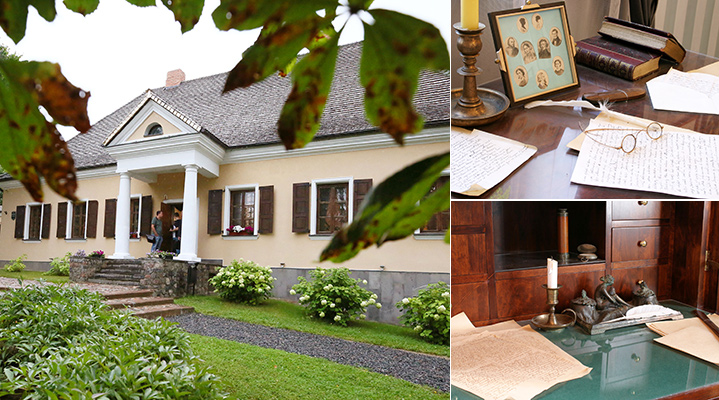
The Novogrudok museum of the outstanding Romanticist poet has been one of the most visited in Grodno Oblast for many decades. The idea of creating an exhibition or a library in the house where Adam Mickiewicz lived was first voiced and even decreed by the authorities in 1920. At that time a project was launched to gather a collection, but the plans were disrupted by the Soviet-Polish war and delayed for a decade.
In the 1930s, thanks to “Mickiewicz’s Committee”, a group of volunteers led by the local governor, the work on the house museum resumed. The museum opened on 11 September 1938. Unfortunately, in June 1941, the building was badly damaged by a German air bomb and a majority of exhibits were lost for good. After the war, the remnants of the collection were taken to Poland.
To mark 100 years since Adam Mickiewicz’s death in 1955, the museum was restored to its pre-war look. A large-scale renovation of the estate of the Mickiewicz family was carried out in 1989-1990. The house was restored to its 19th-century look, an outbuilding connected with the house by an underground tunnel was built, a barn, a well, a gazebo, and other structures were reconstructed.
Today, the museum comprises five exhibition halls. The first one tells about Adam Mickiewicz’s family and displays documents, portraits of his parents and brothers, personal belongings. The second hall is dedicated to the poet’s father Mikolaj Mickiewicz who was a lawyer. The third hall – previously a living room – boasts the interior design of the late 18th – early 19th centuries. The exhibits displayed there include the old clock that once stood in the room of student Adam Mickiewicz, materials about his university studies, and priceless rarities: manuscripts of his first works and copies of the first editions of his first books. The fourth exhibition hall tells about Adam Mickiewicz’s life in Saint Petersburg and Moscow. It displays his books published in Russia and other countries and copies of Adam Mickiewicz’s portraits. The fifth hall is devoted to the poet’s life in Germany, Switzerland, Italy, France, and Turkey. Items exhibited there include portraits of his wife, children, and of famous figures who met with Adam Mickiewicz during that period.
The house museum also features a hall for temporary exhibitions and several permanent exhibitions (for example, dedicated to the kitchen of the Mickiewicz family, to the poem “Pan Tadeusz”). The museum offers excursions in the Belarusian, Russian, Polish, and English languages.
Where: 1 Lenina Street
Adam Mickiewicz’s Mound
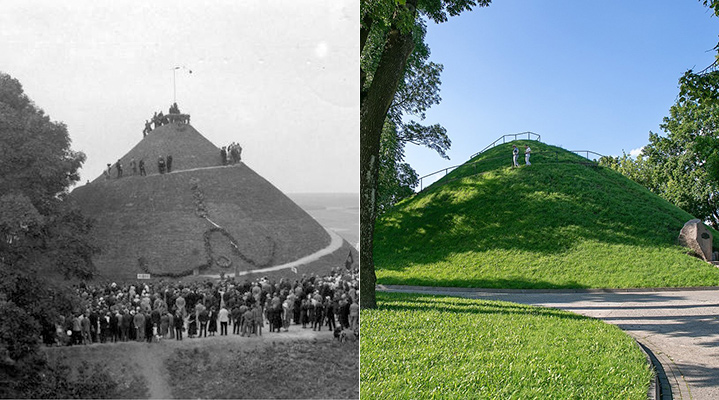
Adam Mickiewicz’s Mound is a unique manmade monument of the 20th century and the only mound dedicated to a person in Belarus. In the 1920s, the poet’s most ardent fans – local residents, scholars, and tourists – created this hill with their own hands. It is located in the historical center of Novogrudok, in the territory of Novogrudok Castle. On 27 May 1924, a capsule containing a piece of parchment with a message was placed in the ground at the site of the future mound. The ground for the mound was brought to Novogrudok from various cities and countries, even sent by mail. The work finished by June 1931.
A commemorative stele was installed at the bottom of the mound. In 1998, during the celebrations of the poet’s 200th anniversary, it was replaced with a commemorative boulder.
It is symbolic that the mound was created in the place where Adam Mickiewicz spent his childhood and where events of many of his works take place. The Mound is on the list of Belarus’ historical and cultural heritage as a landmark of international significance.
Monument to Adam Mickiewicz
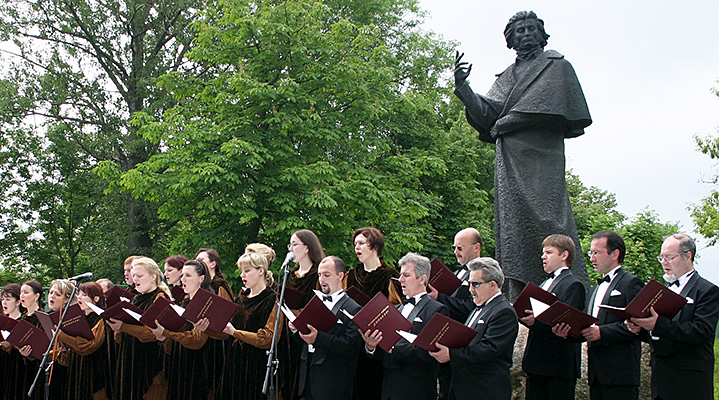
A monument to Adam Mickiewicz was installed at the Castle Hill, near Adam Mickiewicz’s Mound and the Farny Church, where the poet was baptized. It is a statue of the young poet in a long cloak, with streaming hair and a raised hand. The sculpture together with the boulder it stands on is 3.1m high.
Novogrudok Local History Museum
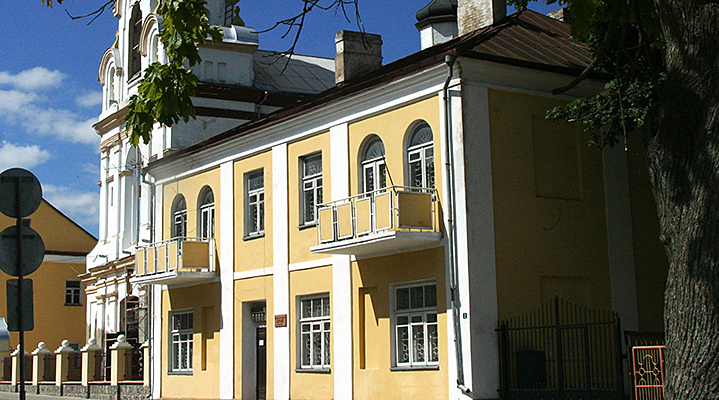
A local history museum opened in the ancient city of Novogrudok only in 1992. However, historians and archaeologists had collected valuable items of the past for many decades. Nowadays, the museum tells about the history and culture of the lands around Novogrudok from the establishment of the town to the middle of the 20th century. The holdings of the museum include around 22,000 items comprising 14 collections.
Unification of lands, the coronation of Mindouh, the golden age and decline of Novogrudok after it lost its status of the capital, the town’s important political role as the venue of sessions of the Sejm and the Tribunal of the Grand Duchy of Lithuania… The museum showcases numerous interesting archeological findings, original copies of documents, and items from the town’s glorious past. The exhibition highlights that Novogrudok was a multinational town, because throughout the history, it was home to Belarusians, Tatars, Poles, and the Jewish people. It was also a place where different religions: Christianity, Islam, and Judaism – coexisted peacefully.
A separate exposition of the museum is dedicated to the Great Patriotic War. During the war, Novogrudok was occupied by the invaders and suffered terrible losses. The local Jewish community was almost completely wiped out…
Another exhibition hall tells about outstanding people born in Novogrudok, including Belarus’ first memoirist Fyodor Yevlashovsky, first folklorist Solomon Rysinsky, the last chancellor of the Grand Duchy of Lithuania Litawor Chreptowicz – a member of the education commission (the first enlightenment ministry in Europe), the founder of the famous library in the Shchorsy estate, reformer and philanthropist, and others.
Where: 2 Grodnenskaya Street
Jewish Resistance Museum
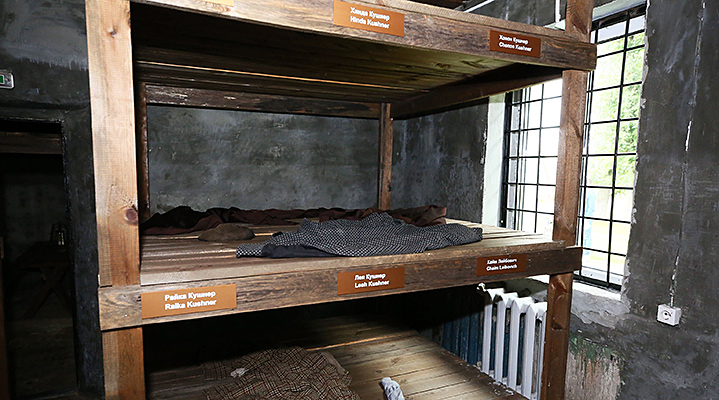
This touching commemorative exposition was created as part of the local lore and history museum and is dedicated to the resistance movement of Novogrudok District’s Jews during the Holocaust. The exposition is located in a former barrack of the Jewish ghetto and tells visitors about the tragedy that took 5,100 human lives. It also informs about the unbelievable fight of those who survived after four cruel Nazi “purges”.
On 26 September 1943 prisoners of the Novogrudok Ghetto fled via a tunnel 250 meters long. It had taken four months to dig that tunnel. The escape was the largest one and the most successful one among thousands of attempts made by Jews to escape death in Europe. 232 people survived largely because Europe’s largest Jewish partisan unit operated in the Novogrudok area. The unit was created back in June 1942.
The unit’s commanding officer Tuviya Belsky grew up in the nearby village of Stankevichi and allowed anyone to join the unit regardless of whether they could become fighters or not. He did it only to save lives! Over 1,300 joined the unit during the war and about 1,200 of them survived.
The Jewish Resistance Museum has two rooms where life in the barracks is demonstrated. The museum also offers a reconstruction of the entrance to the tunnel and has an exposition dedicated to organizers and participants of the escape attempt, Belsky’s partisan unit, and the local residents who helped save Jews.
Apart from that, buildings that used to house workshops for the ghetto prisoners during the war and a well have been preserved at premises of a local vocational school.
Where: 66 Minskaya Street
Kastus Kachan’s Manor Art Gallery
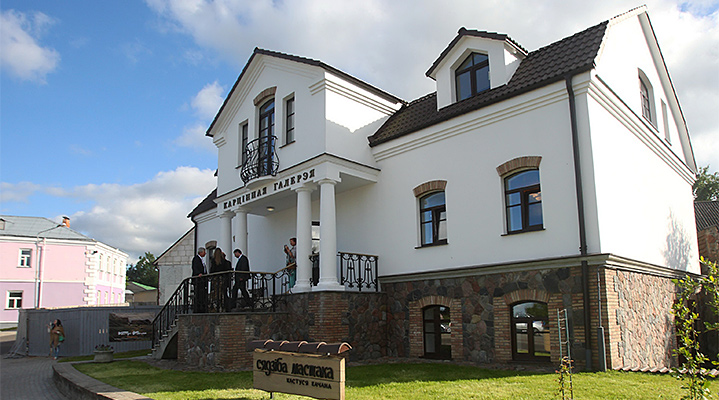
The art gallery was created in Novogrudok upon the initiative of the painter himself. Konstantin Kochan (Kastus Kachan in Belarusian) is a local. For a long time the workshop of the famous landscape painter was located in Minsk downtown but his soul relaxed and he worked productively only in the native town. An ancient building styled like a manor of the gentry was reconstructed in Zamkovaya Street, Novogrudok with the assistance of colleagues, friends, and local residents. The manor houses the painter’s studio, exhibition halls, art space for creative events, a family dining hall, a café and a platform with a magnificent view of the ancient town. The gallery offers a collection of glass items, furniture, and household items from the past.
The gallery’s host Kastus Kachan often participates in excursions, tells visitors about his art, and hosts painting workshops. By the way, works by the landscape painter can now be found in the National Art Museum of Belarus and other major collections in Belarus, in private collections in Germany, Poland, Czechia, Austria, China…
Shopping stalls
Shopping stalls, which were built in the market square in 1812, are a notable place in Novogrudok. The Classicism-style stalls initially had a colonnade. Later on, the stalls were restored and rebuilt time and time again. A large building in the center of the place has not survived the passage of time but the buildings that still stand remind of the history of this popular place. Shops work in the shopping stalls these days.
Where: 3 Minskaya Street
Vladimir Vysotsky’s monument and Vladimir Vysotsky‘s room in the Novogrudok Hotel
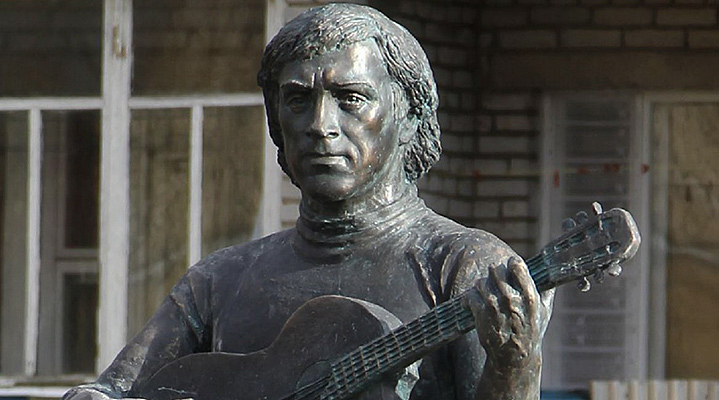
Vladimir Vysotsky was a talented poet, singer, and actor. He was an idol for several generations of Soviet people, the voice of an era that people know and love for many decades. In his time his travels took him to Novogrudok. In 1969 Vladimir Vysotsky came here for the production of the Sons Go Into Battle movie by the famous Belarusian movie director Viktor Turov. Vladimir Vysotsky spent several weeks in Novogrudok and a village near the ancient beautiful Lake Litovka, which was praised by Adam Mickiewicz back in the day. However, Vladimir Vysotsky did not play a role in the movie. Viktor Turov was the first movie director to order movie songs from Vladimir Vysotsky. Virtually within one night Vladimir Vysotsky wrote lyrics and music for four songs. Three became part of the movie.
Vladimir Vysotsky’s portrait sculpture was erected in Novogrudok in 2012 upon the initiative of grateful fans in remembrance of that event. A commemorative room was furnished in the Novogrudok Hotel where the poet lived and where his muse – the French actress and singer Marina Vlady – stayed as a guest. The room uses a retro style interior design and is dedicated to Vladimir Vysotsky. Items from those days are exhibited there: furniture, vinyl discs and a vinyl record player, postcards which were released ahead of Vladimir Vysotsky’s jubilee in 1988. Shots from famous movies and rare photos of the actor during his stay in Novogrudok hang on the walls. The room is not a museum and guests can still stay there.


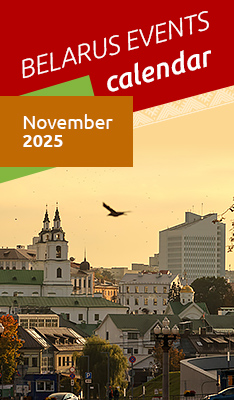




 send friend
send friend print version
print version make home page
make home page add to bookmarks
add to bookmarks
